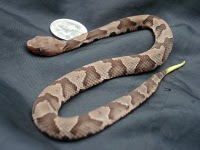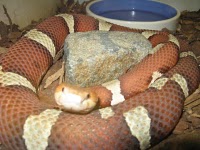One of our adult volunteers came across this dead baby copperhead snake (left) while walking our donkey Lightning last Thursday, and brought it to us so that we could use it for educational purposes. I thought it would be a great chance to compare a North Carolina copperhead to a Texas cop perhead (right), which is what we have on exhibit here. The North Carolina copperhead has an hourglass pattern on its back, whereas the Texas copperhead has large bands as its pattern. The baby copperhead pictured here is much lighter than our Texas copperhead, but adult N.C. copperheads are typically darker.
perhead (right), which is what we have on exhibit here. The North Carolina copperhead has an hourglass pattern on its back, whereas the Texas copperhead has large bands as its pattern. The baby copperhead pictured here is much lighter than our Texas copperhead, but adult N.C. copperheads are typically darker.
 If you look closely, you will notice that the end of the tail on the baby copperhead is a bright green. Copperheads are born with a bright green or yellow tail that they use to catch their prey when they are young. The baby snake will sit in the grass and put the tip of its tail in the air and wiggle it back and forth so that it resembles a worm, and then wait for a small frog to come eat the “worm”! This impressive bright-colored tip of the tail is a great tool to use when trying to determine if a small snake is a copperhead. If you see our adult Texas copperhead snake on exhibit, you will notice that the very end of his tail still has a hint of green in it from when he was younger!
If you look closely, you will notice that the end of the tail on the baby copperhead is a bright green. Copperheads are born with a bright green or yellow tail that they use to catch their prey when they are young. The baby snake will sit in the grass and put the tip of its tail in the air and wiggle it back and forth so that it resembles a worm, and then wait for a small frog to come eat the “worm”! This impressive bright-colored tip of the tail is a great tool to use when trying to determine if a small snake is a copperhead. If you see our adult Texas copperhead snake on exhibit, you will notice that the very end of his tail still has a hint of green in it from when he was younger!